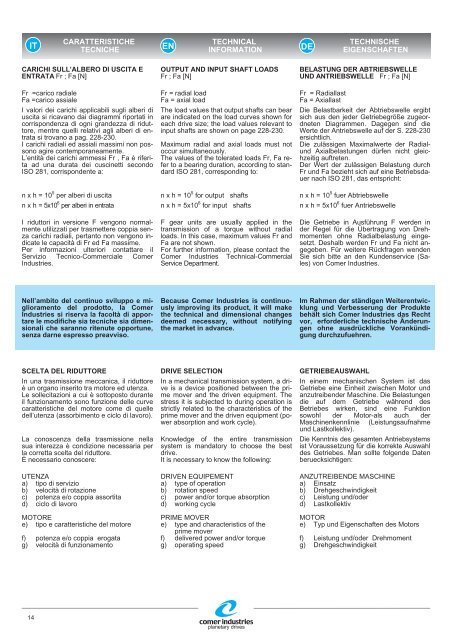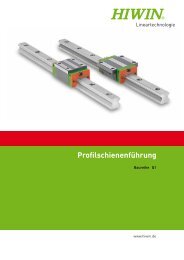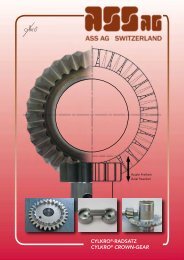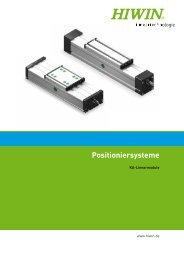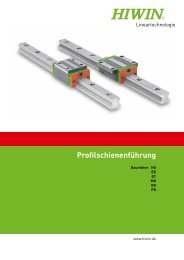Create successful ePaper yourself
Turn your PDF publications into a flip-book with our unique Google optimized e-Paper software.
CARATTERISTICHE<br />
TECHNICAL<br />
IT<br />
TECNICHE EN INFORMATION DE<br />
CARICHI SULL’ALBERO DI USCITA E<br />
ENTRATA Fr;Fa[N]<br />
Fr =carico radiale<br />
Fa =carico assiale<br />
I valori dei carichi applicabili sugli alberi di<br />
uscita si ricavano dai diagrammi riportati in<br />
corrispondenza di ogni grandezza di riduttore,<br />
mentre quelli relativi agli alberi di entrata<br />
si trovano a pag. 228-230.<br />
I carichi radiali ed assiali massimi non possono<br />
agire contemporaneamente.<br />
L’entità dei carichi ammessi Fr , Fa è riferita<br />
ad una durata dei cuscinetti secondo<br />
ISO 281, corrispondente a:<br />
nxh=<strong>10</strong> 5 per alberi di uscita<br />
nxh=5x<strong>10</strong> 6 per alberi in entrata<br />
I riduttori in versione F vengono normalmente<br />
utilizzati per trasmettere coppia senza<br />
carichi radiali, pertanto non vengono indicate<br />
le capacità di Fr ed Fa massime.<br />
Per informazioni ulteriori contattare il<br />
Servizio Tecnico-Commerciale Comer<br />
Industries.<br />
Nell’ambito del continuo sviluppo e miglioramento<br />
del prodotto, la Comer<br />
Industries si riserva la facoltà di apportare<br />
le modifiche sia tecniche sia dimensionali<br />
che saranno ritenute opportune,<br />
senza darne espresso preavviso.<br />
14<br />
OUTPUT AND INPUT SHAFT LOADS<br />
Fr;Fa[N]<br />
Fr = radial load<br />
Fa = axial load<br />
The load values that output shafts can bear<br />
are indicated on the load curves shown for<br />
each drive size; the load values relevant to<br />
input shafts are shown on page 228-230.<br />
Maximum radial and axial loads must not<br />
occur simultaneously.<br />
The values of the tolerated loads Fr, Fa refer<br />
to a bearing duration, according to standard<br />
ISO 281, corresponding to:<br />
nxh=<strong>10</strong> 5 for output shafts<br />
nxh=5x<strong>10</strong> 6 for input shafts<br />
F gear units are usually applied in the<br />
transmission of a torque without radial<br />
loads. In this case, maximum values Fr and<br />
Fa are not shown.<br />
For further information, please contact the<br />
Comer Industries Technical-Commercial<br />
Service Department.<br />
Because Comer Industries is continuously<br />
improving its product, it will make<br />
the technical and dimensional changes<br />
deemed necessary, without notifying<br />
the market in advance.<br />
DRIVEN EQUIPEMENT<br />
a) type of operation<br />
b) rotation speed<br />
c) power and/or torque absorption<br />
d) working cycle<br />
PRIME MOVER<br />
e) type and characteristics of the<br />
prime mover<br />
f) delivered power and/or torque<br />
g) operating speed<br />
BELASTUNG DER ABTRIEBSWELLE<br />
UND ANTRIEBSWELLE Fr;Fa[N]<br />
Fr = Radiallast<br />
Fa = Axiallast<br />
Die Belastbarkeit der Abtriebswelle ergibt<br />
sich aus den jeder Getriebegröße zugeordneten<br />
Diagrammen. Dagegen sind die<br />
Werte der Antriebswelle auf der S. 228-230<br />
ersichtlich.<br />
Die zulässigen Maximalwerte der Radialund<br />
Axialbelastungen dürfen nicht gleichzeitig<br />
auftreten.<br />
Der Wert der zulässigen Belastung durch<br />
Fr und Fa bezieht sich auf eine Betriebsdauer<br />
nach ISO 281, das entspricht:<br />
nxh=<strong>10</strong> 5 fuer Abtriebswelle<br />
nxh=5x<strong>10</strong> 6 fuer Antriebswelle<br />
Die Getriebe in Ausführung F werden in<br />
der Regel für die Übertragung von Drehmomenten<br />
ohne Radialbelastung eingesetzt.<br />
Deshalb werden Fr und Fa nicht angegeben.<br />
Für weitere Rückfragen wenden<br />
Sie sich bitte an den Kundenservice (Sales)<br />
von Comer Industries.<br />
Im Rahmen der ständigen Weiterentwicklung<br />
und Verbesserung der Produkte<br />
behält sich Comer Industries das Recht<br />
vor, erforderliche technische Änderungen<br />
ohne ausdrückliche Vorankündigung<br />
durchzufuehren.<br />
SCELTA DEL RIDUTTORE<br />
DRIVE SELECTION<br />
GETRIEBEAUSWAHL<br />
In una trasmissione meccanica, il riduttore<br />
è un organo inserito tra motore ed utenza.<br />
Le sollecitazioni a cui è sottoposto durante<br />
il funzionamento sono funzione delle curve<br />
caratteristiche del motore come di quelle<br />
dell’utenza (assorbimento e ciclo di lavoro).<br />
In a mechanical transmission system, a drive<br />
is a device positioned between the prime<br />
mover and the driven equipment. The<br />
stress it is subjected to during operation is<br />
strictly related to the characteristics of the<br />
prime mover and the driven equipment (power<br />
absorption and work cycle).<br />
In einem mechanischen System ist das<br />
Getriebe eine Einheit zwischen Motor und<br />
anzutreibender Maschine. Die Belastungen<br />
die auf dem Getriebe während des<br />
Betriebes wirken, sind eine Funktion<br />
sowohl der Motor-als auch der<br />
Maschinenkennlinie (Leistungsaufnahme<br />
und Lastkollektiv).<br />
La conoscenza della trasmissione nella<br />
sua interezza è condizione necessaria per<br />
la corretta scelta del riduttore.<br />
È necessario conoscere:<br />
Knowledge of the entire transmission<br />
system is mandatory to choose the best<br />
drive.<br />
It is necessary to know the following:<br />
Die Kenntnis des gesamten Antriebsystems<br />
ist Voraussetzung für die korrekte Auswahl<br />
des Getriebes. Man sollte folgende Daten<br />
beruecksichtigen:<br />
UTENZA<br />
a) tipo di servizio<br />
b) velocità di rotazione<br />
c) potenza e/o coppia assortita<br />
d) ciclo di lavoro<br />
MOTORE<br />
e) tipo e caratteristiche del motore<br />
f) potenza e/o coppia erogata<br />
g) velocità di funzionamento<br />
TECHNISCHE<br />
EIGENSCHAFTEN<br />
ANZUTREIBENDE MASCHINE<br />
a) Einsatz<br />
b) Drehgeschwindigkeit<br />
c) Leistung und/oder<br />
d) Lastkollektiv<br />
MOTOR<br />
e) Typ und Eigenschaften des Motors<br />
f) Leistung und/oder Drehmoment<br />
g) Drehgeschwindigkeit


